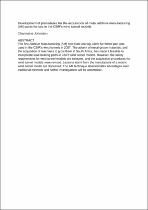 ResearchSpace
ResearchSpace
Development of procedures for the acquisition of metal Additive Manufacturing (AM) parts for use in the CSIR's wind tunnel models
JavaScript is disabled for your browser. Some features of this site may not work without it.
- ResearchSpace
- →
- Research Publications/Outputs
- →
- Conference Publications
- →
- View Item
| dc.contributor.author |
Johnston, C

|
|
| dc.date.accessioned | 2017-08-22T13:10:00Z | |
| dc.date.available | 2017-08-22T13:10:00Z | |
| dc.date.issued | 2015-11-04 | |
| dc.identifier.citation | Johnston, C. Development of procedures for the acquisition of metal Additive Manufacturing (AM) parts for use in the CSIR's wind tunnel models. In: Rapid Product Development Association of South Africa (RAPDASA) 16th Annual International Conference, 4 - 6 November 2015, Roodevallei, Pretoria, 11pp | en_US |
| dc.identifier.other | URI not available anymore | |
| dc.identifier.uri | http://hdl.handle.net/10204/9468 | |
| dc.description | Copyright: 2015 RAPDASA. Due to copyright restrictions, the attached PDF file only contains the abstract of the full text item. | en_US |
| dc.description.abstract | The first Additive Manufacturing (AM) non-load-bearing, client furnished part was used in the CSIR’s wind tunnels in 2007. The advent of metal-grown materials, and the acquisition of machines to grow them in South Africa, has made it feasible to incorporate load-bearing parts in CSIR wind tunnel models. However, the safety requirements for wind tunnel models are stringent, and the acquisition procedures for wind tunnel models were revised. Lessons learnt from the manufacture of a recent wind tunnel model are discussed. The AM technique demonstrates advantages over traditional methods and further investigations will be undertaken. | en_US |
| dc.language.iso | en | en_US |
| dc.publisher | Rapid Product Development Association of South Africa (RAPDASA) | en_US |
| dc.relation.ispartofseries | Worklist;15989 | |
| dc.subject | Additive manufacturing | en_US |
| dc.subject | AM | en_US |
| dc.subject | Wind tunnel models | en_US |
| dc.title | Development of procedures for the acquisition of metal Additive Manufacturing (AM) parts for use in the CSIR's wind tunnel models | en_US |
| dc.type | Conference Presentation | en_US |
| dc.identifier.apacitation | Johnston, C. (2015). Development of procedures for the acquisition of metal Additive Manufacturing (AM) parts for use in the CSIR's wind tunnel models. Rapid Product Development Association of South Africa (RAPDASA). http://hdl.handle.net/10204/9468 | en_ZA |
| dc.identifier.chicagocitation | Johnston, C. "Development of procedures for the acquisition of metal Additive Manufacturing (AM) parts for use in the CSIR's wind tunnel models." (2015): http://hdl.handle.net/10204/9468 | en_ZA |
| dc.identifier.vancouvercitation | Johnston C, Development of procedures for the acquisition of metal Additive Manufacturing (AM) parts for use in the CSIR's wind tunnel models; Rapid Product Development Association of South Africa (RAPDASA); 2015. http://hdl.handle.net/10204/9468 . | en_ZA |
| dc.identifier.ris | TY - Conference Presentation AU - Johnston, C AB - The first Additive Manufacturing (AM) non-load-bearing, client furnished part was used in the CSIR’s wind tunnels in 2007. The advent of metal-grown materials, and the acquisition of machines to grow them in South Africa, has made it feasible to incorporate load-bearing parts in CSIR wind tunnel models. However, the safety requirements for wind tunnel models are stringent, and the acquisition procedures for wind tunnel models were revised. Lessons learnt from the manufacture of a recent wind tunnel model are discussed. The AM technique demonstrates advantages over traditional methods and further investigations will be undertaken. DA - 2015-11-04 DB - ResearchSpace DP - CSIR KW - Additive manufacturing KW - AM KW - Wind tunnel models LK - https://researchspace.csir.co.za PY - 2015 T1 - Development of procedures for the acquisition of metal Additive Manufacturing (AM) parts for use in the CSIR's wind tunnel models TI - Development of procedures for the acquisition of metal Additive Manufacturing (AM) parts for use in the CSIR's wind tunnel models UR - http://hdl.handle.net/10204/9468 ER - | en_ZA |





